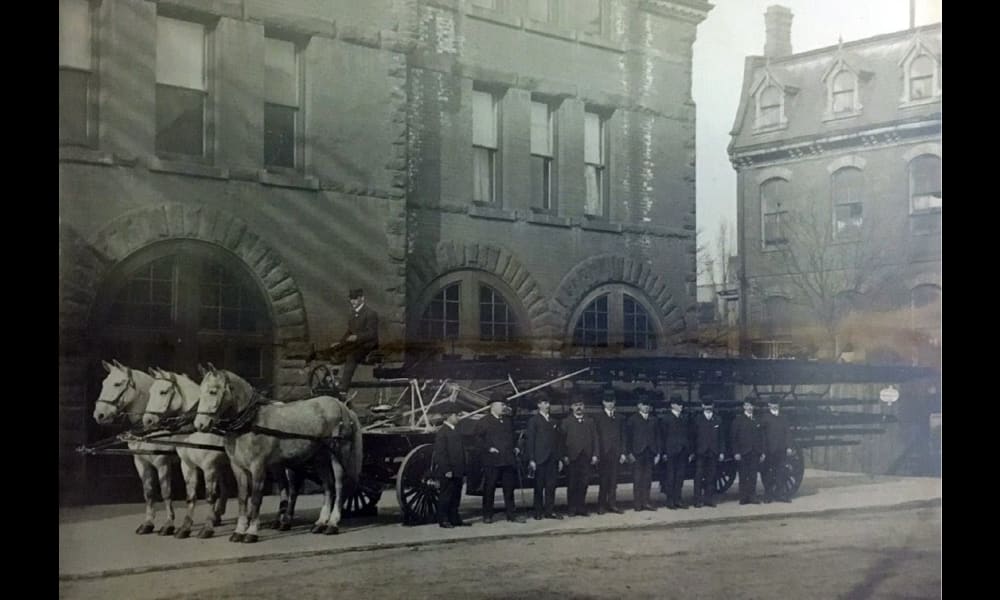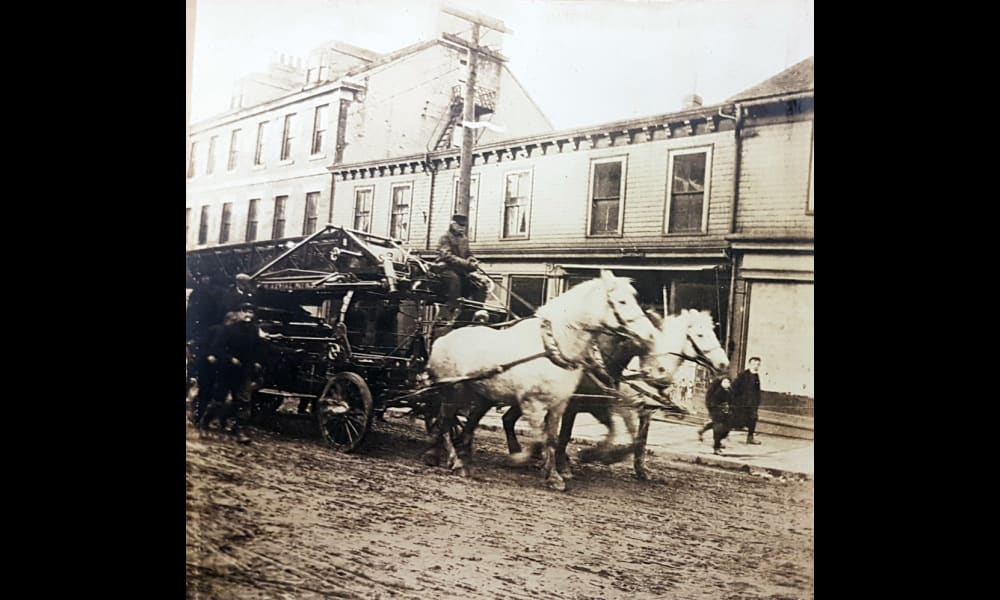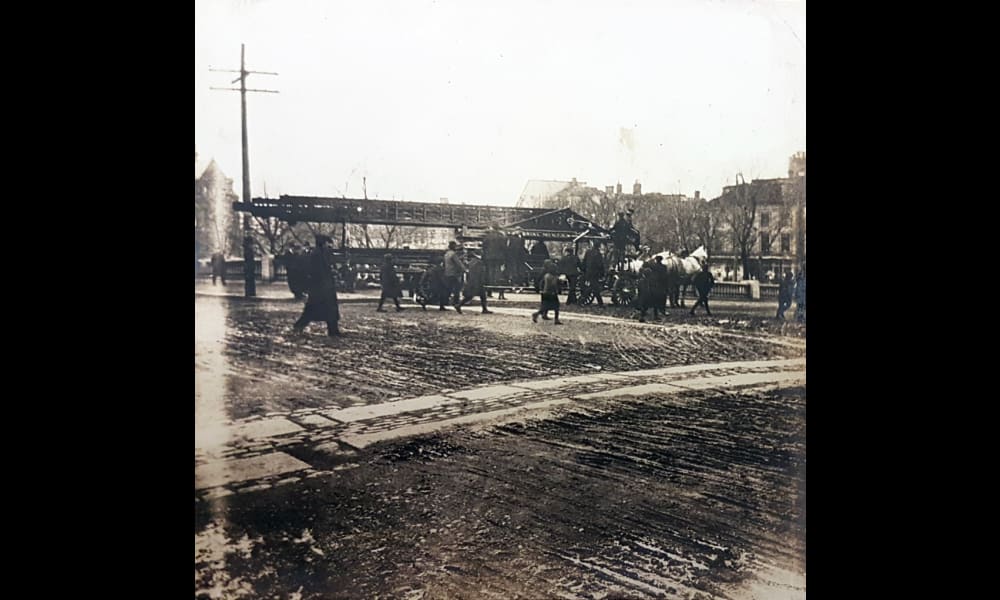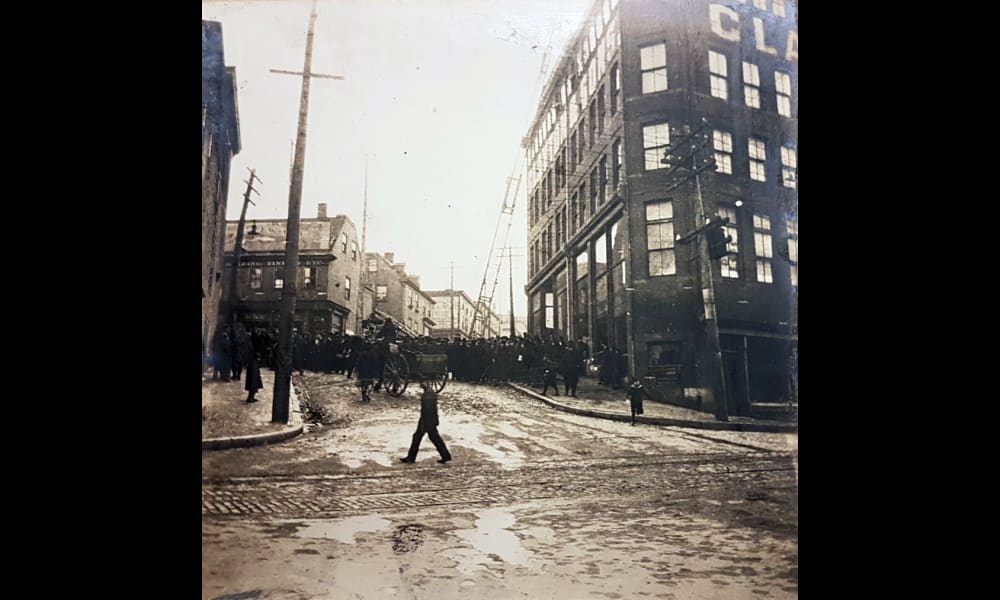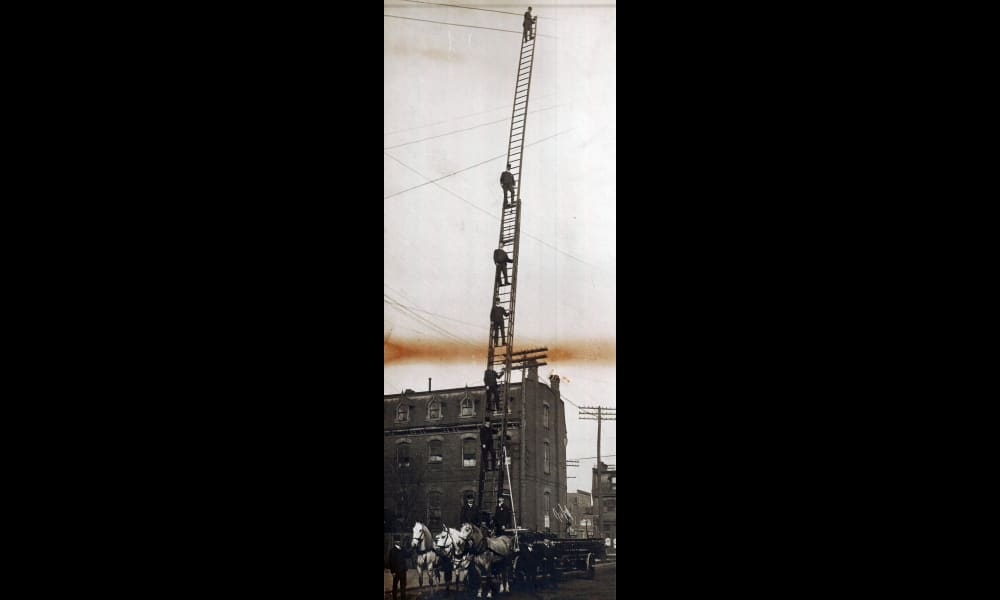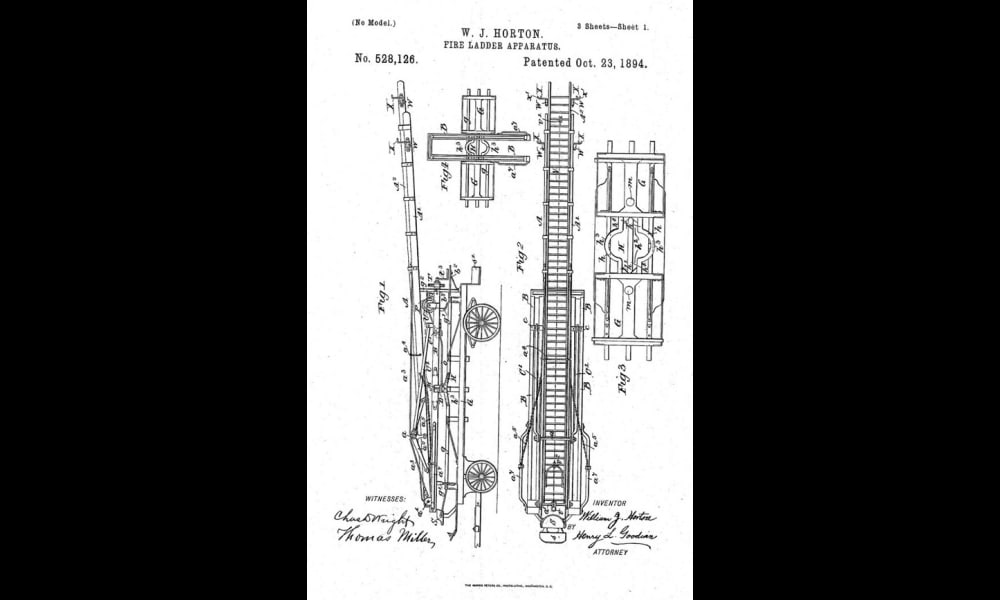1909 Horton 80' Aerial
• The following research was done by friend of the Halifax Fire Historical Society, Pete Ziobrowski, our go-to for all things historically architectural related. As always, thanks Pete!
• Recently firefighter/engineer Jeff Brown showed me the above photo, wondering if i could place it. He told me the man standing Second from the left, was Halifax Councillor JJ Hines, and the Apparatus behind him was a 1909 Horton Aerial Ladder, which was Halifax fire Department's first aerial. We knew this was not a Halifax Firehall, and so began a search to learn more about the Horton.
• The Horton was purchased at the urging of the insurance underwriters who were concerned that Halifax lacked any sort of aerial appliance. The Cities Board of fire wards had been suggesting the procurement of an Aerial ladder for a number of years, and in their report to Council of March 6, 1906 identified the need for new engines to replace old equipment, and to expand coverage due to city growth. The report recommended procuring:
· 1x Hose Wagon
· 1x 650gal Engine
· 1x Combination chemical Engine and Ladder truck
· 1x Aerial Ladder truck and Equipment.
• The Aerial was required due to Electrical and Telephone wires making "Old Fashioned Ladders" of little use in the business District, and explained that Aerial designs are the only type that can be erected in a modern city. Council agreed with the report, agreeing to buy the equipment, but an amendment was moved to remove the Aerial. The vote was lost on a tie-breaking vote by the Mayor. Halifax would get it aerial, and in July the City advertised tenders for the equipment.
• In August, council accepted a tender form the Halifax Firm of Macdonald & Co. Ltd. to supply an 80' Horton Aerial Truck, subject to meeting department specifications.
• The Horton Aerial ladder was patented in 1894 by another Haligonian W.J Horton. Hortons design was intended to "improve the construction of fire ladder apparatus in such manner as shall make them more efficient in use and so that the apparatus shall in its construction and operation combine the practical advantages of the ordinary hand ladder truck a main extension ladder useful at high buildings, and a substantial water tower."
• There must have been some wiggle room in the design, as in February 1907, council sends Chief Broderick to Quebec, Montreal and Toronto to inspect Aerial Ladders in Use, and to assist in preparations of requirements for the Halifax Department's ladder. Chief Broderick submitted his report to council in March.
• Going back to the photo that started all this, the first thought was that the photo was out side the Premises of MacDonald & Co. A quick look at a 1908 city directory put them on Barrington street, just past Jacob St, however this area was the location of the Clayton & Sons Factory, not the building pictured. Consultation with staff at the Nova Scotia Archives suggested that the Photo was not in Halifax. Stephen Archibald googled fire station postcards, and determined that the photo was taken in Toronto, in front of the Lombard St. Station, which would later become the Second City Comedy Club. The photo was likely taken on Chief Broderick's trip examining Aerial Ladders.
• MacDonald & Co ltd. was sent a letter on 9 October notifying them of the award. They supplied specifications to the board of firewards in early November, with the board responding that the provided specifications were "vague and unsatisfactory". Several meetings were held between representatives of the Board and MacDonald & Co, but information supplied by the company remained vague, and they declined to supply blueprints. The Board of Firewards finally made an appearance at the premises of MacDonald & Co on May 30, 1907, and demanded to see the Aerial Ladder. They left, having seen neither the ladder nor any of its parts.
• At the June 3rd 1907 meeting of the board of firewards, the board had had enough. The board passed a motion formally rejecting the plans stating that the specifications provided by the company were not suitable for the board of fire ward's needs. the boards report to council recommended ending the contract, and buying the Seagrave 80' Aerial Ladder for $5350.00. When council met 7 days later, the motion as recommended is put forward. Roderick MacDonald requests to address council, and is permitted to do so. In his presentation he presents a model of the Horton Aerial Ladder.
• This presentation prompts council to pass a series of motions granting a 3 month extension from that date for MacDonald & co to construct a latter, if Roderick MacDonald accepts, otherwise to authorize the cancellation of the contract and buy the Seagrave. MacDonald accepts, and the motion passes giving him until September 10 to deliver the ladder.
• In February 1908, the board of firewards recommends equipping the Aerial ladder (if Purchased) with 150' of three inch hose and a ladder turret attachment to enable the ladder to be used as a water tower, at the request of Chief Broderick.
• July 9th, the Nova Scotia Board of fire underwriters writes the board of firewards recommending tests for acceptance of the aerial ladder. the test include determining the minimum number of men required to handle the ladder, the fastest erection time, and performance while flowing an aerial stream. The board of firewards motions to send a letter to Mr. Macdonald giving him 10days address the tests, or the city will have no further dealings with him. In august, the city recommends further tests.
• These tests were conducted September 30th. The results as reported to council recall that the Nova Scotia Furnishing building is located on Barrington Street, between Prince and Sackville streets. Suffice to say, the ladder was found to have failed testing, and a Dec 14 1908 motion of the board of firewards - Testing confirmed ladder did not meet requirements, and the board of firewards recommends the truck not be accepted, and that the city have no further dealings with MacDonald & Co on the matter of the board of firewards dismissal came before council on Jan 7 1909. the motion at council is to accept the the board of fireward's recommendation. at the meeting Roderick Macdonald asks to address council and speak in his interest. After Roderick Macdonald's presentation (the contents of which are not recorded in the minutes) A new motion is made to accept the aerial, and passed by a vote of 12 for to 4 against. A motion of council authorized payment of $4900.00 for the Aerial ladder in Febuary 1909, in response to a letter from Macdonald & Co Ltd. in April the chief was instructed to prepare estimates for the board on the Annual cost to commission the Horton Aerial. council also received letters from citizens wondering when the latter would be put in service as the insurance underwrites had promised a $0.05 discount. The discount was promised in a 1904 memo to the city, and indicated an 80' turntable ladder with 8 call-men crew would warrant the discount. In response to city inquiries, the underwriters agreed that the discount was still available, but only when proficiency with the latter could be proven.
•The initial estimates for horses and hitching gear came in at 1500.00 for setup, and a cost of over $2000.00 annually. By December 1909 the Department had a crew of 8 who could erect the ladder in under 3 minutes, and shift in in under one minute. Council directed the board of firewards to prepare estimates for the ladder to be put into service after may 1 1910. It was also decided that a 9 member panel would need to be satisfied for the underwriters to honor their discount pledge. the board would be made up of 3 members each from the Board of firewards, the board of fire underwriters, and the Halifax board of trade.
• On March 23 the committee rendered their decision that the Horton Aerial ladder was "a workable piece of apparatus" and the discount would be applied to all policies. The ladder went into service.
________________________________________________
• This ladder truck was sold for $250.00 to the Reconstruction Committee on December 24, 1917 (source: Halifax Municipal Archives, Board of Control minutes of December 24, 1917, p. 615).


